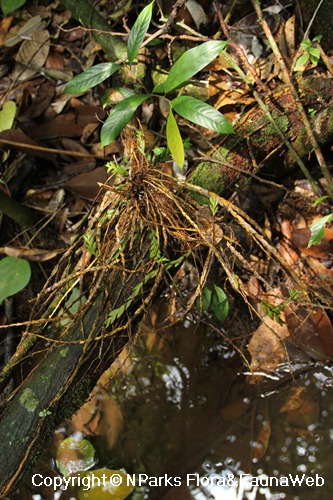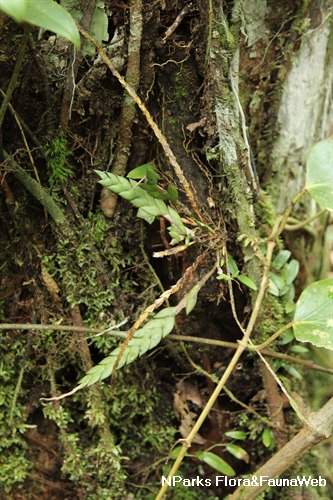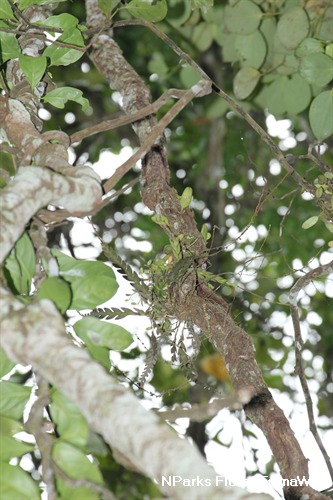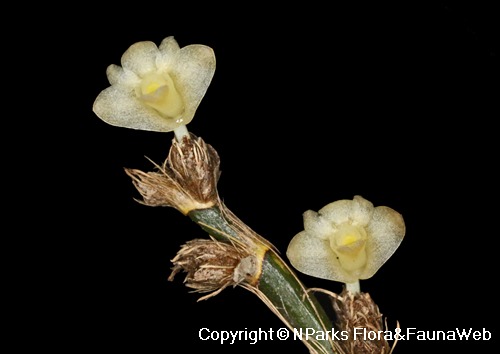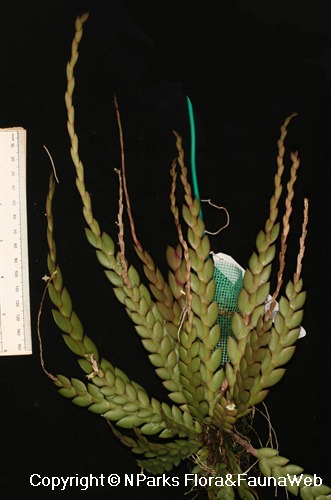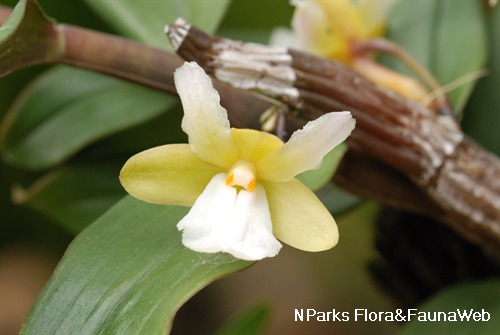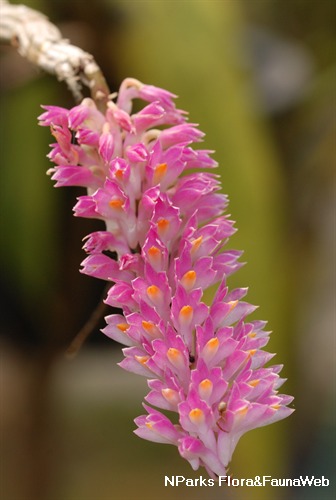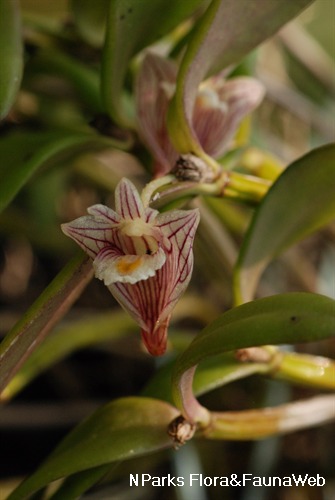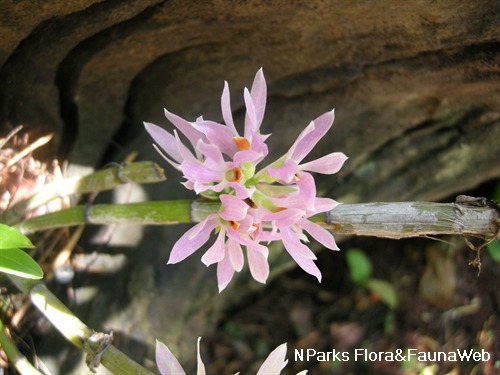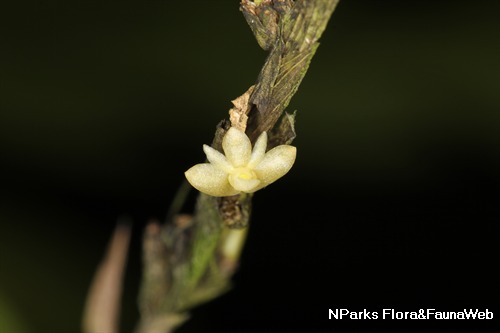
Back
Dendrobium aloifolium (Blume) Rchb.f.
| Family Name: | Orchidaceae |
| Synonyms: | Aporum aloifolium (Blume) Brieger, Aporum cochichinensis (Ridl.) Rauschert, Aporum lobbii M.A. Clem., Aporum micranthum Griff., Aporum serra Lindl., Dendrobium cochichinensis Ridl., Dendrobium serra (Lindl.) Lindl. |
Name
Classifications and Characteristics
| Plant Division | Angiosperms (Flowering Seed Plants) (Monocotyledon) |
|---|---|
| Plant Growth Form | Epiphyte |
| Lifespan (in Singapore) | Perennial |
| Mode of Nutrition | Autotrophic |
Biogeography
| Native Distribution | Singapore, Myanmar, Thailand, Malaysia, Borneo, Cambodia, Laos, Vietnam, Indonesia, New Guinea and Philippines |
|---|---|
| Native Habitat | Terrestrial (Primary Rainforest, Secondary Rainforest, Freshwater Swamp Forest) |
| Preferred Climate Zone | Tropical |
| Local Conservation Status | Native to Singapore (Critically Endangered (CR)) |
| CITES Protection | True (Appendix II) |
Description and Ethnobotany
| Growth Form | It is an epiphytic orchid with flattened stems, 40 - 60 cm long, upright when young and becoming pendulous when mature. |
|---|---|
| Foliage | Its fleshy, flattened leaves are 2.5 cm long and 7 mm wide, oblique and acute, overlapping each other along the basal part of the stem. The apical portion of stem is covered only by sheathing leaves which usually bears the flowers. |
| Flowers | Its flowers are about 4 mm long and wide, white to cream in colour and reflexed backwards soon after opening. |
| Others - Plant Morphology | It was thought to be extinct in the wild in Singapore until it was rediscovered in 2010 (Ang et al., 2010). |
| Habitat | It grows in lowland forests, often in bright and wet areas. |
| Etymology | Greek dendro-bios, tree-dwelling, referring to the epiphytic growth habit of the species in the genus. Latin aloifolium, aloe-leaved, referring to the aloe-like leaves of the plant. |
Landscaping Features
| Landscaping | It is suitable for parks and gardens for planting on trees as an epiphyte. |
|---|---|
| Desirable Plant Features | Ornamental Foliage, Ornamental Form |
| Landscape Uses | Parks & Gardens, Small Gardens, Vertical Greenery / Green Wall, Skyrise / Balcony |
| Thematic Landscaping | Naturalistic Garden |
Fauna, Pollination and Dispersal
| Pollination Method(s) | Biotic (Fauna) |
|---|---|
| Seed or Spore Dispersal | Abiotic (Explosive Dehiscence) |
Plant Care and Propagation
| Light Preference | Semi-Shade |
|---|---|
| Water Preference | Little Water, Occasional Misting |
| Maintenance Requirements | Moderate |
| Propagation Method | Seed, Division, Tissue Culture |
Foliar
| Foliage Retention | Evergreen |
|---|---|
| Mature Foliage Colour(s) | Green |
| Mature Foliage Texture(s) | Smooth, Thick |
| Foliar Type | Simple / Unifoliate |
| Foliar Arrangement Along Stem | Alternate |
| Foliar Shape(s) | Non-Palm Foliage (Asymmetrical) |
| Foliar Venation | Parallel |
| Foliar Margin | Entire |
| Foliar Apex - Tip | Acute |
| Leaf Area Index (LAI) for Green Plot Ratio | 3.5 (Shrub & Groundcover - Monocot) |
| Typical Foliar Size | 25 mm |
Non - Foliar and Storage
| Root Type | Underground, Aboveground |
|---|
Floral (Angiosperm)
| Flower & Plant Sexuality | Bisexual Flowers |
| Flower Colour(s) | Cream / Off-White |
|---|---|
| Flower Grouping | Solitary |
| Flower Location | Axillary |
| Flower Size | 4 mm |
Fruit, Seed and Spore
| Mature Fruit Colour(s) | Brown |
|---|---|
| Fruit Classification | Simple Fruit |
| Fruit Type | Dehiscent Dry Fruit , Capsule |
| Seed Description | Numerous and microscopic. They are dust-like and lack endosperm. |
| Seed Quantity Per Fruit | Numerous (>20) |
References
| References | Ang, W. F., A. F. S. L. Lok, C. K. Yeo, S. Y. Tan & Hugh T. W. Tan. 2010. Rediscovery of Dendrobium aloifolium (Blume) Rchb.f. (Orchidaceae) in Singapore.. Nature in Singapore. 3. 321–325. 5 |
|---|
Image Repository
Others
| Master ID | 30703 |
|---|---|
| Species ID | 5015 |
| Flora Disclaimer | The information in this website has been compiled from reliable sources, such as reference works on medicinal plants. It is not a substitute for medical advice or treatment and NParks does not purport to provide any medical advice. Readers should always consult his/her physician before using or consuming a plant for medicinal purposes. |

